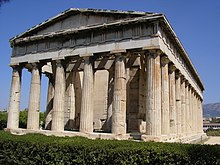Peripteros
Peripteros (Greek ὁ περίπτερος <ναός> - the "ring-winged" temple, also called peripteral temple or ring hall temple ) is a type of ancient temple in which the cella is surrounded by a pteron, which is bordered by a column wreath ( peristasis ) .
The peripteros is probably the best known and most widespread form of the Greek temple . His naos is almost always formed as an antic temple or a double antic temple . Therefore, the peripteros usually has a pronaos and possibly an opisthodoma , which are formed from the protruding ante and mostly two columns in between.
The peripteros usually has six columns on the fronts and backs. The number of columns on the long sides, however, could vary greatly. While it was particularly high in archaic times (Heraion in Olympia (Greece) with 6 × 16 columns), the solution with 13 columns on the long sides for the Doric temples settled in classical times . But temples with 6 × 15 columns (Temple of Apollo in Delphi ) or 6 × 14 (Temple of Athena Alea in Tegea ) continued to appear, even if only as a reminiscence of archaic models. At the transition to Hellenism , the proportions could be more compact, as the temple of Asclepius in Epidauros with 6 × 11 columns or the Athena in Pergamon with 6 × 10 columns prove. A special form among the Doric temples is the Parthenon on the Acropolis of Athens with its 8 × 17 columns. Nevertheless, it also follows the classic relationship of column disposition according to the scheme of front columns: flank columns = n: 2n + 1.
Peripteroi of the ionic order were usually somewhat smaller in size and more compact in their columnar ratio. The Temple of Zeus in Labraunda had only 6 × 8 columns, the Temple of Apollo in Alabanda only 6 × 9 columns, and the Temple of Athena in Priene 6 × 11 columns. Nevertheless, temples of archaic times could have 6 × 18 columns there ( Heraion of Samos ).
The Peripteroi in Greater Greece were often unconventional . In addition to classical solutions (Temple of Athena in Paestum with 6 × 13 columns), numerous temples had elongated proportions of 6 × 14 or 6 × 15 columns, which for many can be traced back to their origin in archaic times. But there were also temples with an uneven number of front columns, such as Hera Temple I (so-called basilica) in Paestum with its 9 × 18 columns, which nevertheless should not be regarded as a pseudodipteros . In this temple, contrary to all custom, the front yokes were shortened compared to the flank yokes, while the classic solution would suggest the reverse design or uniform yoke widths.
In general, a certain degree of independence of the individual building parts is much more common in southern Italy. While the temples of the motherland or Ionia have firmly integrated the naos into the rhythm of the pillars, in which the pillars and wall arrays are clearly related to each other, the Greek structures seem to float in the surrounding ring hall. Often neither the cell walls were aligned in any way with the front pillars, nor did the ante end with a line to be determined from the lower pillar diameter or the axis widths.
The few temples in Lower and Central Italy that can be addressed as Peripteros always have squat columnar proportions, such as the Temple of Apollo in Pompeii (6 × 10 columns), Temple A in the Area sacra di Largo Argentina in Rome (6 × 9 columns) or the Temple of Castor on the Roman Forum in Rome (6 × 11 columns).
In ancient Egypt , too , temples were built in a similar form as temple temple, one example is the temple of Amenophis III. on Elephantine .
Related temple types
If the columns on the long sides are only faded in front of the naos as half columns , one speaks of a pseudoperipteros . A peripteros with a double column wreath is called a dipteros . This design also occurs in a modification, the pseudodipteros , the inner column position of which has been omitted.
Further examples
- the temple of Hephaestus in the agora of Athens
- the Temple of Poseidon at Cape Sounion
- the temples of Paestum
- the temples of Akragas
literature
- Manfred Bietak (Ed.): Archaic Greek Temples and Ancient Egypt. Austrian Academy of Sciences, Vienna 2001, ISBN 3-7001-2937-8 .
- Hans Bonnet: Peripteros. In: Lexicon of Egyptian Religious History. Nikol, Hamburg 2000, ISBN 3-937872-08-6 , p. 586.
- Gottfried Gruben : The temples of the Greeks. 5th edition, Hirmer, Munich 2001, ISBN 3-7774-8460-1 .
- Heiner Knell : Architecture of the Greeks: Basic features. Scientific Book Society, Darmstadt 1988, ISBN 3-534-80028-1 .
- Wolfgang Müller-Wiener : Greek construction in antiquity. Beck, Munich 1988, ISBN 3-406-32993-4 .

